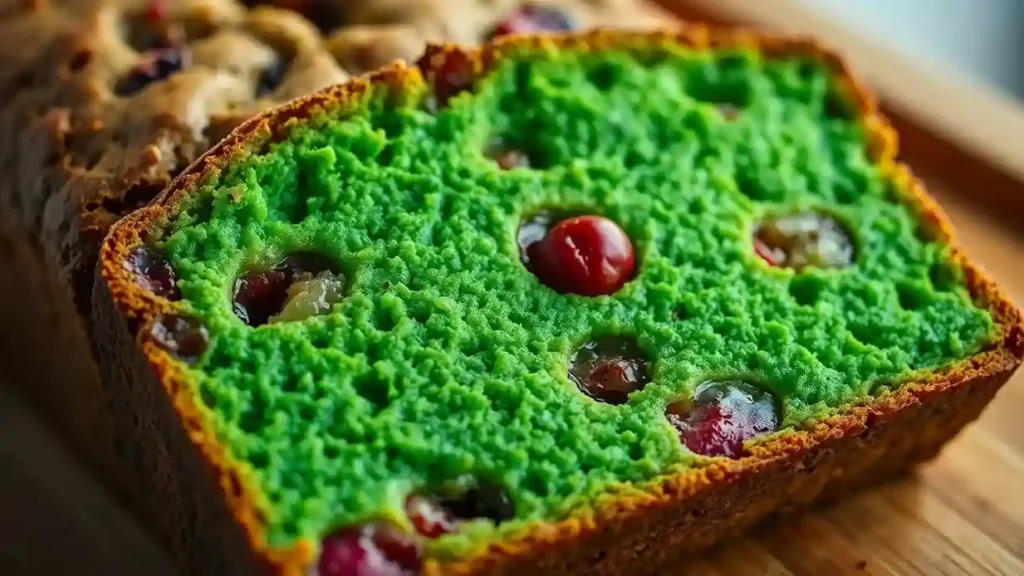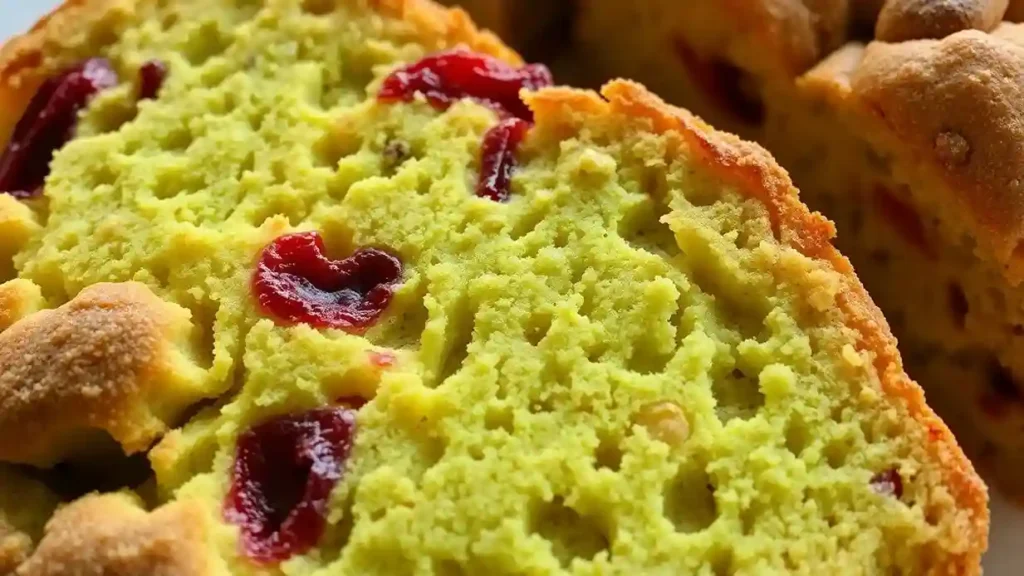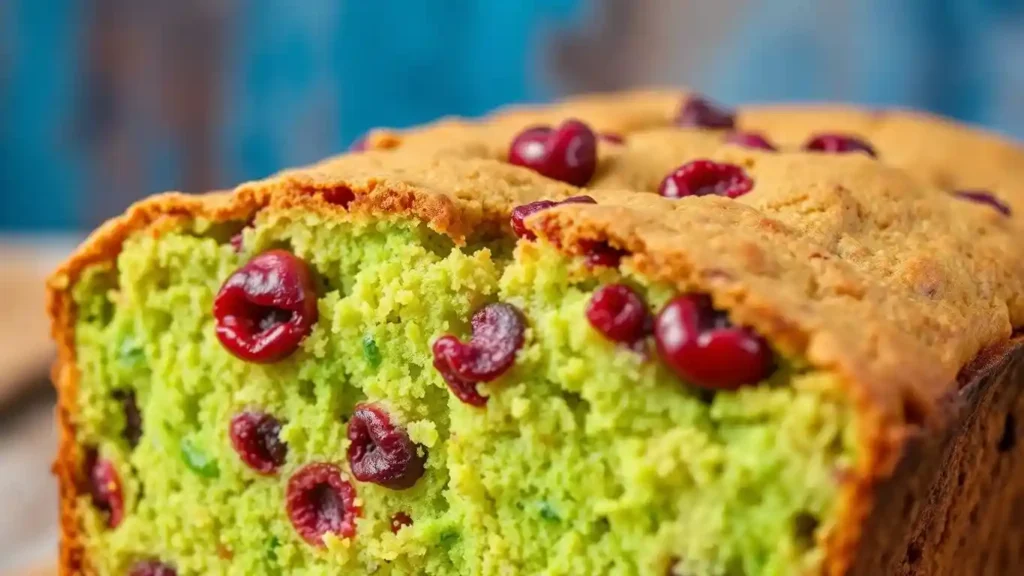Ever baked cranberry bread and found it turning a weird green color? You’re not alone. This happens more often than you’d think, and it’s usually a surprise to anyone who pulls a loaf out of the oven expecting a golden-brown crust. The good news is, it’s often just a harmless reaction between the cranberries and the baking soda you used. But there are ways to prevent this from happening if the green hue isn’t your thing. Let’s dive into why your cranberry bread might turn green and how you can avoid it.
Table of contents
Key Takeaways
- Cranberry bread can turn green due to a reaction between acidic cranberries and baking soda.
- Over-chopping cranberries can increase the likelihood of the bread turning green.
- Using the right amount of baking soda can help prevent the green color.
- Aluminum-free baking powder might reduce the chances of green bread.
- Green cranberry bread is usually safe to eat, but adjust ingredients if the color bothers you.
Understanding Why Cranberry Bread Turn Green

Chemical Reactions with Baking Soda
When baking cranberry bread, the interaction between baking soda and cranberries can create unexpected results. Baking soda is alkaline, and when it meets the acidic nature of cranberries, a chemical reaction occurs. This reaction can sometimes cause the bread to turn a surprising green color. It’s all about balancing the ingredients to avoid this odd hue.
Role of Cranberry Acidity
Cranberries are naturally tart, thanks to their acidity. This acidity plays a crucial role in the bread’s flavor but can also affect its color. The acid in cranberries reacts with the alkaline baking soda, shifting the color of the bread. To keep your bread from turning green, consider using a bit less baking soda or balancing it with a kefir substitute for buttermilk.
Impact of Overly Chopped Cranberries
Chopping cranberries too finely can exacerbate the color change. When cranberries are overly chopped, more juice is released, increasing the acidity and enhancing the reaction with baking soda. To maintain that fresh flavor and avoid a green loaf, chop your cranberries into medium-sized pieces. This will help keep the balance right and your bread golden brown instead of green.
The unexpected green hue in your cranberry bread is a common baking quirk. It’s all about the chemistry between ingredients, and with a few tweaks, you can enjoy a perfectly colored loaf every time.
Preventing Cranberry Bread Turn Green in Your Baking

Using the Right Amount of Baking Soda
Ever notice how your cranberry bread sometimes turns green? The culprit might be the baking soda. Too much of it can cause a reaction with the acidic cranberries, leading to that odd color. Start by reducing the amount of baking soda in your recipe by about a third. If you’re using a tablespoon, try two teaspoons instead. This small adjustment can make a big difference.
Gentle Mixing Techniques
When it comes to mixing your batter, less is more. Overmixing can cause the cranberries to break down too much, releasing more acid and increasing the chances of a chemical reaction. Aim for a gentle hand when combining ingredients. Stir just until the dry ingredients are moistened, and you’ll have a better chance of keeping your bread the right color.
Alternative Ingredients to Consider
If you’re still seeing green, consider swapping out some ingredients. Using kefir as a leavening agent can help balance the acidity without the need for extra baking soda. Kefir’s unique properties not only aid in the rise of your bread but also enhance its texture. Plus, it pairs well with cranberries, adding a subtle tang that complements the fruit. Alternatively, try using aluminum-free baking powder, which can also help prevent discoloration in your baked goods.
Exploring the Science Behind Cranberry Bread Turn Green

Anthocyanins and pH Levels
Baking can be a science experiment in your kitchen. One of the colorful surprises you might encounter is the green hue in cranberry bread. This color change often comes from anthocyanins, the pigments found in cranberries. These pigments react to pH levels, shifting colors based on acidity or alkalinity. When you use a teaspoon baking soda, it can make the batter more alkaline, causing those vibrant reds to turn green.
Common Reactions with Other Fruits
Cranberries aren’t the only fruits that can change colors during baking. Other fruits, like blueberries and blackberries, can also surprise you. The magic happens when fruits meet baking powder or baking soda. It’s a dance of chemistry where sugar particles and fruit acids play a role, often leading to unexpected hues.
The Role of Aluminum-Free Baking Powder
Switching to aluminum-free baking powder can help avoid unwanted color changes. Aluminum in baking powder reacts with acidic ingredients, leading to discoloration. When baking cranberry bread, consider using an aluminum-free option to maintain the natural color.
To prevent green bread, use the right amount of leavening agents and avoid overmixing. Try baking at a consistent temperature for 50-55 minutes to achieve the perfect loaf.
Incorporating these tips can help you bake a delightful cranberry bread without the unexpected green surprise. Remember, baking is all about balance and understanding how ingredients interact.
For more insights on baking techniques, check out kefir sheet cake variations to explore creative ways of mixing and ingredient preparation.
Common Mistakes Leading to Green Cranberry Bread
Excessive Use of Leavening Agents
When it comes to baking, the balance of ingredients is everything. Using too much baking soda or baking powder can lead to unexpected results, like your cranberry bread turning green. The alkaline nature of these leavening agents can react with the natural acidity of cranberries, causing a color change. To avoid this, make sure to measure your leavening agents accurately, using the recommended amounts in your recipe.
Improper Ingredient Measurements
Precision is key in baking. If you’re eyeballing measurements or using the wrong tools, you might end up with more than just a green loaf. Over or under-measuring ingredients like flour, sugar, or cranberries can affect the texture and color of your bread. For best results, use a kitchen scale or proper measuring cups and spoons to ensure each ingredient is just right.
Overmixing the Batter
Mixing your batter too much can also be a culprit. When you overmix, you’re not just blending ingredients—you’re also activating gluten and potentially bruising the cranberries. This can lead to a denser texture and, yes, a greenish hue. Stir just until the ingredients are combined for a tender, perfectly colored loaf.
Baking is as much a science as it is an art. Paying attention to details, especially with measurements and mixing techniques, can save you from a green surprise in your cranberry bread.
For more baking tips and to avoid common pitfalls like over-baking your dessert, check out how to master the art of crème brûlée.
Safe to Eat: When Green Bread is Not a Problem
Understanding Safe Chemical Reactions
Sometimes, cranberries in your bread can react with baking soda, causing a green tint. Don’t worry, it’s safe to eat! This color change is due to a harmless chemical reaction between the acid in cranberries and the alkaline nature of baking soda. Just like the reaction you might see with sunflower seeds, it’s not harmful at all.
When to Be Concerned
While a green hue is usually nothing to worry about, there are times when you should be cautious:
- If the bread smells off or sour.
- When you notice mold growing, which typically appears after 5-10 minutes of exposure to air.
- If the texture seems unusually slimy or sticky.
Tips for Peace of Mind
- Cool it completely: Let your cranberry bread cool for at least 10-15 minutes before slicing. This helps stabilize the texture and color.
- Store properly: Wrap it tightly in plastic wrap or keep it in an airtight container to prevent further reactions.
- Check the ingredients: Ensure you’re using fresh baking soda and quality cranberries to minimize unexpected reactions.
It’s comforting to know that a little green in your cranberry bread is usually just a quirky kitchen science at play, not a cause for alarm. Enjoy your baking adventures without fear!
Alternative Solutions for Perfect Cranberry Bread
Adjusting Baking Techniques
Creating the ideal cranberry bread isn’t just about the ingredients; it’s also about the method. Start by ensuring your cranberries are well-distributed in the batter. Tossing fresh cranberries in a bit of flour can prevent them from sinking to the bottom. This simple trick keeps them evenly spread throughout the loaf.
When mixing your ingredients, be gentle. Overmixing can lead to a dense loaf rather than a tender crumb. Combine your wet mixture and dry mixture just until they come together. Use a separate bowl for your dry ingredients like flour, granulated sugar, and a teaspoon cinnamon before adding them to the wet mixture of melted butter and orange juice. This helps in achieving that perfect balance.
Experimenting with Acidity Levels
The tartness of cranberries is a signature taste, but it can also lead to unexpected green hues if not balanced correctly. To counteract this, consider adjusting the acidity in your recipe. You might try adding a bit less orange juice or replacing some with apple butter. This small change can make a significant difference in the final color and taste of your cranberry bread.
Exploring Different Recipes
If you’re up for a bit of adventure, explore variations like cranberry orange walnut or cranberry pecan bread. These tweaks not only add new flavors but also change the texture. For a holiday season twist, try incorporating cranberry sauce or cranberry ice. You can even sprinkle some crunchy turbinado sugar on top for a delightful crunch.
Baking is as much about experimentation as it is about precision. Don’t shy away from trying new techniques or ingredients to find your perfect cranberry bread.
Once your bread is baked, let it cool on a wire rack lined with parchment paper. This ensures even cooling and prevents the bottom from becoming soggy. Enjoy your delicious bread with a cup of coffee or as a sweet treat during the holiday season. Whether you’re making a cranberry orange muffin or a simple loaf, these tips can help you achieve a delightful result every time.
The Role of Ingredients in Bread Coloration
Impact of Baking Soda and Powder
Baking soda and baking powder are essential in baking, but they can lead to unexpected changes in your bread’s color. Baking soda, an alkaline substance, reacts with acidic ingredients, which can sometimes turn cranberry bread green. If you’re using baking powder, especially one with aluminum, this can also cause a change in color. Opting for aluminum-free baking powder can help maintain the desired hue.
Influence of Fruit Acidity
Cranberries are naturally acidic, and when they interact with the flour mixture and leavening agents, they can contribute to the greenish tint. This is because the acidity can cause the pH levels to shift, affecting the overall color. To balance this, consider adjusting the amount of sweet ingredients to offset the acidity or use an alternative acidic ingredient like lemon juice to control the pH.
Effect of Mixing Methods
How you mix your ingredients can also impact the color of your bread. Overmixing the batter can lead to more intense chemical reactions between the acidic cranberries and the leavening agents. To avoid this, gently fold the ingredients together, ensuring even distribution without overworking the dough. This gentle approach can help maintain a consistent color throughout your loaf.
When baking, the interplay of simple ingredients can lead to surprising results. Understanding these interactions helps you take control of your baking outcomes.
Conclusion
So, if your cranberry bread turned a bit green, don’t worry too much. It’s just a quirky reaction between the cranberries and baking soda. Next time, try using a little less baking soda or gently folding in the cranberries to keep that from happening. Remember, even if it looks a bit odd, it’s still perfectly safe to eat. Baking is all about experimenting and learning, so take this as a fun lesson in kitchen chemistry. Happy baking!
Frequently Asked Questions
How can I replace fresh cranberries with dried ones in my bread?
Use 25% less dried cranberries than fresh ones. Dried cranberries are more flavorful and smaller, so you don’t need as many. Soak them in hot water for five minutes to make them plump and juicy.
What can I add to my cranberry bread for extra flavor?
Try mixing in chocolate chips or chopped nuts like walnuts or pecans. Add about half a cup to the batter for a delicious twist.
How do I know when my cranberry bread is done baking?
You can check with a toothpick—insert it into the center, and if it comes out clean, the bread is done. An instant-read thermometer should show 195 to 200ºF.
Why does my cranberry bread sometimes turn green?
The green color comes from a reaction between the acidic cranberries and baking soda. Cranberries have anthocyanins that change color with different pH levels. Avoid this by using the right amount of baking soda and gently folding in the cranberries.
Is it okay to freeze cranberry bread?
Yes, cranberry bread freezes well. You can keep it in the freezer for up to three months. Just wrap it tightly to keep it fresh.
Can I use frozen cranberries instead of fresh ones?
Yes, you can use frozen cranberries. Don’t thaw them before using. You might need to bake the bread for a few extra minutes.
